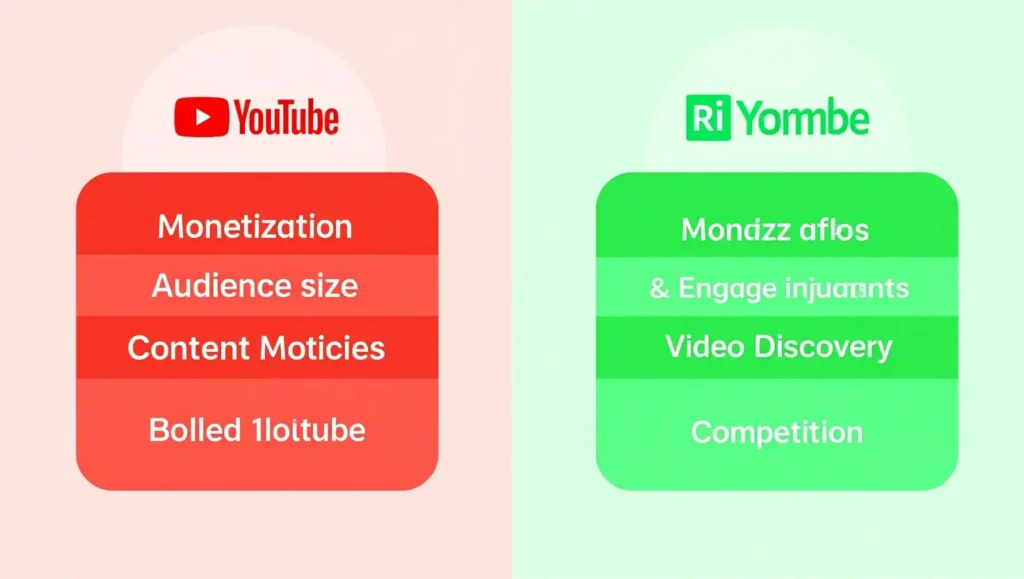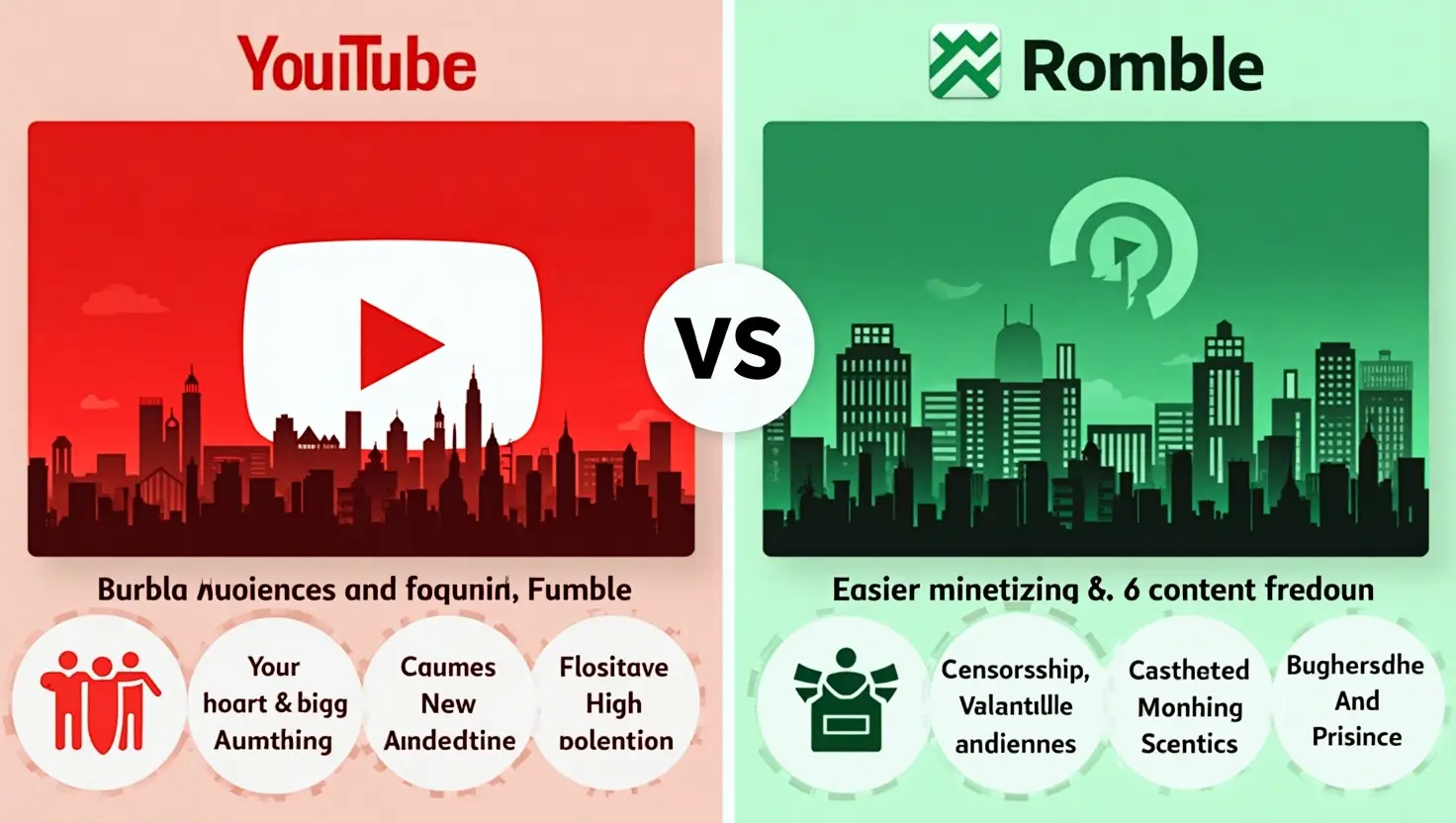The online video landscape is more competitive than ever, and choosing the right platform can significantly impact your success as a content creator. While YouTube vs. Rumble has long been a topic of debate, both platforms offer unique advantages. YouTube and Rumble differ in monetization, content policies, and audience reach, making it crucial to analyze which platform best aligns with your goals.
- What is Rumble?
- What is YouTube?
- YouTube vs Rumble: A Side-by-Side Comparison
- Which Platform Pays More?
- Content Freedom & Restrictions: Where Do You Have More Control?
- Audience & Growth Potential: Which Platform Offers More Reach?
- Who Should Use Rumble?
- Who Should Use YouTube?
- Should You Use Both Platforms?
What is Rumble?
Founded in 2013 by Chris Pavlovski, Rumble is a video-sharing platform that has gained traction as an alternative to YouTube. It appeals to creators seeking higher revenue share and less restrictive content policies. Unlike YouTube, Rumble hosts content on its servers, offering greater control over distribution and monetization.
Pros and Cons of Rumble
Pros:
- Easier to gain visibility due to fewer content creators.
- Higher revenue share (60%) compared to YouTube’s 55%.
- Supports high-quality video resolutions (4K and 8K).
- No minimum requirements for monetization.
- Less censorship, making it an attractive option for certain content creators.
- Potential for viral reach through third-party licensing opportunities.
Cons:
- Smaller audience compared to YouTube.
- Limited editing tools and analytics for content creators.
- Weaker content discovery algorithms than YouTube’s AI-powered recommendations.
What is YouTube?
Launched in 2005, YouTube is the largest video-sharing platform in the world, with over 2.7 billion active users each month. Since being acquired by Google in 2006, it has continued to grow, offering multiple monetization options but enforcing strict content guidelines.
Pros and Cons of YouTube
Pros:
- Massive global audience, making it easier to reach a broad user base.
- Advanced tools and analytics to help creators optimize their content.
- Diverse monetization options, including ads, memberships, and brand deals.
- Powerful content discovery algorithms, helping videos gain more views over time.
- Higher CPM rates, mean advertisers pay more per 1,000 views.
- Strong integration with Google search results, boosting discoverability.
Cons:
- Strict monetization requirements (1,000 subscribers and 4,000 watch hours).
- YouTube takes a 45% cut of ad revenue.
- Content policies can lead to demonetization or video removal.
- High competition makes it harder for new creators to gain traction.
YouTube vs Rumble: A Side-by-Side Comparison
| Feature | Rumble | YouTube |
|---|---|---|
| User Base | ~50 million monthly users | 2.7 billion monthly users |
| Monetization | 60% ad revenue share, no minimum threshold | 55% ad revenue share, requires 1K subscribers & 4K watch hours |
| Community Tools | Basic engagement tools | Advanced tools, including memberships and Super Chat |
| Content Policies | Less restrictive | Strict guidelines, risk of demonetization |
| Ad Revenue Potential | Lower CPM rates, but higher revenue share | Higher CPM rates, but lower revenue share |
| Growth Potential | Easier to stand out, but smaller audience | Large audience, but high competition |
| Video Licensing | Option to sell rights to media companies | No external licensing options |
Which Platform Pays More?

For many creators, earning potential is a deciding factor. Here’s how YouTube vs Rumble compare:
Rumble’s Monetization System
- Ad Revenue: Creators earn 60% of ad revenue.
- No Minimum Requirements: You can start earning as soon as you upload content.
- Video Licensing: You can sell video rights to third-party media companies for additional earnings.
- Rumble Partners Program: Offers extra revenue streams for high-performing creators.
YouTube’s Monetization System
- Ad Revenue: Creators receive 55% of ad revenue, while YouTube takes a 45% cut.
- Memberships & Super Chat: Viewers can support their favorite creators with direct payments.
- Sponsorships & Brand Deals: Established creators can collaborate with brands for additional income.
- YouTube Shorts Monetization: Allows short-form content creators to earn revenue.
- YouTube Premium Revenue: Creators earn a share of revenue from YouTube Premium subscribers.
Content Freedom & Restrictions: Where Do You Have More Control?
- Rumble is known for its less restrictive content policies, making it ideal for creators producing content that might be flagged or demonetized on YouTube.
- YouTube enforces strict community guidelines, meaning certain topics may lead to demonetization or video removal.
Audience & Growth Potential: Which Platform Offers More Reach?
If your main goal is maximum audience reach, YouTube is the clear winner. However, YouTube vs Rumble provides different advantages depending on your content strategy. Rumble offers a less competitive environment, which can help newer creators gain traction more quickly.
| Growth Factor | Rumble | YouTube |
| Competition | Lower, easier to gain views | High, difficult to stand out |
| Video Discovery | Developing recommendation system | Advanced AI-driven algorithms |
| Best for | Niche content, quick monetization | Long-term growth, broad audiences |
Who Should Use Rumble?
- New creators who want to start monetizing their content immediately.
- Content creators cover niche or controversial topics that might not comply with YouTube’s policies.
- Those looking for better revenue share and fewer restrictions.
- Is anyone looking for an alternative to YouTube censorship?
- Independent journalists and political commentators seeking unrestricted speech.
Who Should Use YouTube?
- Creators focused on long-term growth and brand-building.
- Businesses and influencers who want access to advanced marketing tools.
- Anyone aiming to reach a massive audience and maximize visibility.
- Those who rely on sponsorships and diverse monetization methods.
Should You Use Both Platforms?
Many creators upload their videos to both YouTube vs Rumble to maximize their earnings and reach. Here’s how you can benefit from both platforms:
- Use YouTube for broad reach and long-term brand building.
- Use Rumble for better revenue share and unrestricted content.
Final Verdict
Both platforms have unique strengths. If you want maximum visibility and long-term growth, YouTube is the better choice. If you prefer easier monetization and fewer content restrictions, Rumble might be the right fit.
For the best results, consider diversifying your content across both platforms. This allows you to take advantage of YouTube vs Rumble benefits. Experiment with both and see what works best for your content strategy!
What’s Your Take?
Have you tried YouTube vs Rumble? Which platform do you prefer and why? Let us know in the comments!


